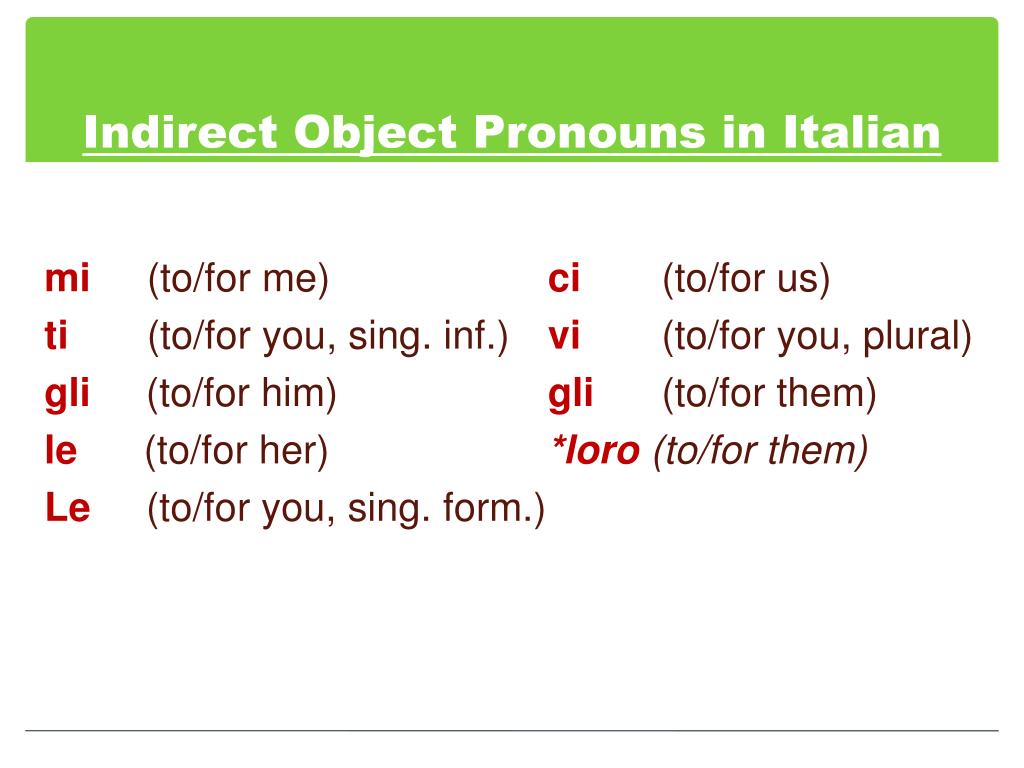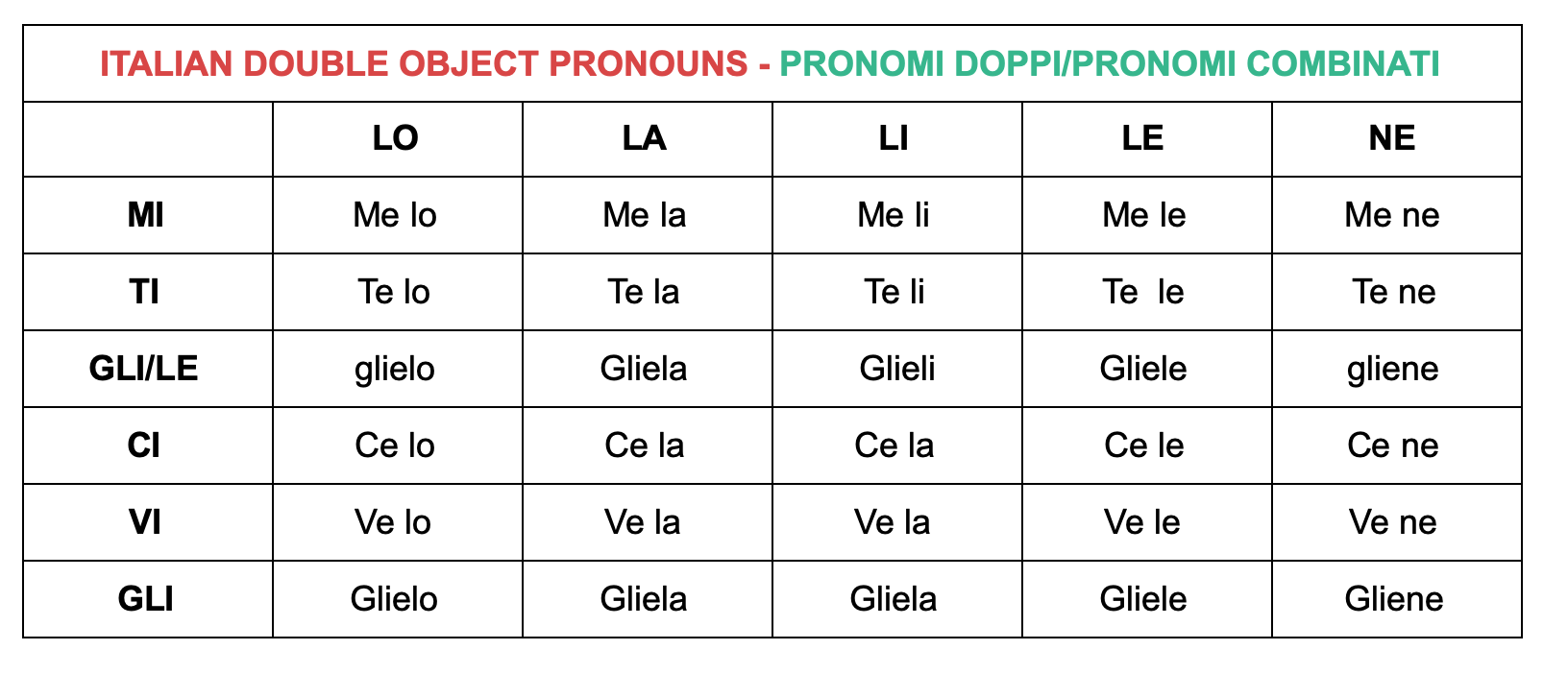
Italian Indirect Object Pronouns A Simple Guide Learn Italian Go
Indirect pronouns Corso d'italiano A1.2, Grammatica, Unità 10 Pronouns often cause problems when learning Italian. In this article, we will learn Italian indirect pronouns, what the indirect object is, and some common verbs that have the indirect object. INTRODUCTION: WHAT IS THE INDIRECT OBJECT

Pin on Итальянский язык
Indirect pronouns The Italian indirect pronouns and useful verbs that use these pronouns. Impara » Direct pronouns The Italian direct pronouns with useful verbs that have these pronouns. Impara » Our learning tip Master Italian pronouns with targeted exercises. I pronomi italiani A1-C1 Grammar Alma Edizioni Rated 5.00 out of 5 19,50 €

indirect object pronouns italian
In this lesson we see the Italian indirect pronouns (mi, ti, gli/le, ci, vi, loro).Printable montly planners here: www.etsy.com/it/shop/ItalianOnlineSchoolNe.

Indirect Object Pronouns in Italian YouTube
Italian Indirect Object Pronouns are the receiver of the verb's action. An Indirect Object tells whom the action described by the verb is directed to, performed for or intended to benefit or harm. The Indirect Object also indicates the person or thing that receives the direct object.

Italian indirect object pronouns Archives Learn Italian Go
Here, ci is the indirect object pronoun for "to us." This example clearly illustrates that indirect object pronouns in Italian are used as indirect complements. They are not the main subjects or the direct objects of sentences. Instead, they link to the verb indirectly, often following small prepositions. Here are some more examples:

PPT Indirect Object Pronouns PowerPoint Presentation, free download ID2367561
In this example the pronouns TI and Mi are indirect pronouns and "Il gelato" is the subject. Other similar verbs are to mancare/to miss, servire/to need, sembrare/ to seem, bastare/ to be enough. THE POSITION OF DIRECT AND INDIRECT PRONOUNS IN ITALIAN. Direct and indirect pronouns usually precede the verb. Let's go back to this example:

Guide to the Italian indirect object pronouns (with AUDIO!)
Indirect object pronouns ( pronomi complemento indiretto) are pronouns that substitute for nouns that serve as the indirect object of the sentence verb, indicating to whom or to what (or for whom or for what, with whom or with what, etc.) an action was done.

Direct and Indirect Object Pronouns Italian Exercises
The direct pronouns in Italian are: Direct pronouns have the function of direct object. Therefore, they are used when the verb is not followed by any preposition and they answer the question "Who? What?". For example: Anna compra il libro = Anna lo compra (Anna buys the book = Anna buys it)

Italian Indirect Object Pronouns A Simple Guide Learn Italian Go
Indirect object pronouns, just like direct object pronouns, precede a conjugated verb, except for loro and Loro, which follow the verb. Le ho dato tre ricette. - I gave her three recipes. Ci offrono un caffè. - They offer us a cup of coffee. Parliamo loro domani. - We'll talk to them tomorrow. A: Che cosa regali allo zio Giovanni?

The Double Object Pronouns in Italian and How to Use Them Smart Italian Learning
Indirect pronouns in Italian take the place of a noun used as a direct object, preceded by the preposition "a". We have already seen these pronouns used with verbs like (Piacere, Bastare, Mancare and Servire).Indirect pronouns, of course, must agree in gender and number with the noun that they replace.

Italian Indirect Object Pronouns A Simple Guide Learn Italian Go
WHAT IS AN INDIRECT PRONOUN Indirect objects are nouns or noun substitutes that typically need a preposition to make the phrase meaningful. For example: " I speak to Laura " becomes meaningless if we say " I speak Laura ." Pronouns that stand for or replace an indirect object are called indirect object pronouns

Italian Indirect Object Pronouns A Simple Guide Learn Italian Go
In the last one, the indirect pronoun le stands for "to her" and it's replacing "a Chiara". Direct pronouns and indirect pronouns: what's the difference? There are two types of pronouns in Italian: direct object pronouns and indirect object pronouns. What makes indirect pronouns different from direct pronouns?

Indirect object pronouns In Italian (Mi, ti, gli, le) tuttoinitaliano
In Italian, indirect object pronouns generally precede the verb, whereas in English they follow it. In addition, the Italian indirect object pronoun replaces both the preposition and the noun, but in English, some verbs have to keep the preposition, while other verbs have the option of keeping it. Per esempio… Attenzione!

Pin on Итальянский язык
Indirect pronouns replace an indirect object and are preceded by a preposition. Indirect pronouns answer the question: to whom? To what? Ind. pron. are: MI (a me) - A me piace la marmellata / I like jam TI (a te) - A te manca tanto Giulia / You miss Giulia so much GLI (a lui) - A lui non piaceva il jazz / He didn't like jazz

A Guide to Italian Indirect Pronouns
Direct Object Pronouns First we need to understand what a direct object is. A direct object is the direct recipient of the action of a verb. For example: She invites the girls. Whom does she invite? The girls. I read the book. What do I read? The book. The nouns girls and book are the direct objects in these cases.

Pin on Italian
What are the Italian indirect object pronouns, and how do they work? A pronoun is a part of speech that replaces a name or a person to avoid repeating them directly in a sentence. This is why they are called pronomi in Italian, from the Latin pro, "in place of", and nomen, "name". Ho regalato a mamma una matita. Le ho regalato una matita.